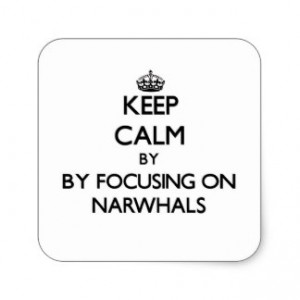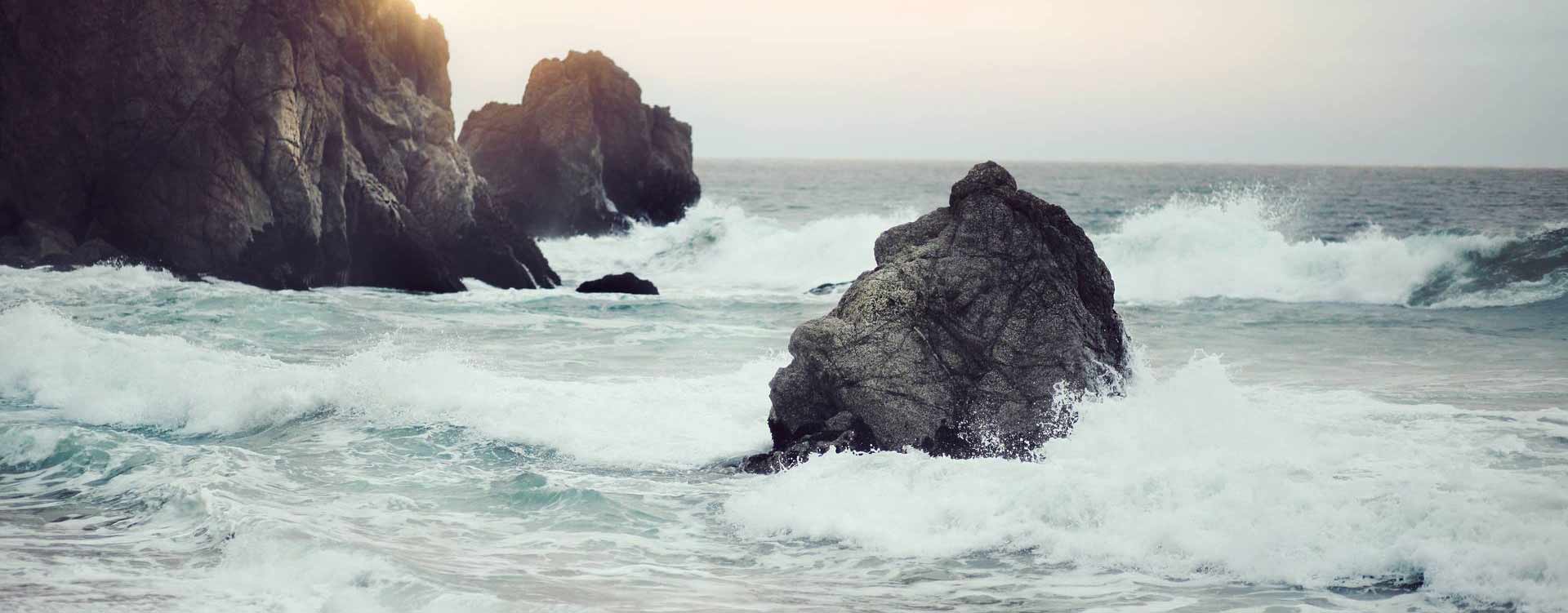
Save the Narwhals
About This Project
Narwhals are Real
The narwhal (Monodon monoceros) is one of the rarest whales in the world. An Arctic species, narwhals are elusive and mysterious, and very distinct in appearance because of their long tusk, which actually is a tooth that grows from the upper jaw of males. The tusks can reach 9-10 feet long. They’re small and chubby as far as whales go, weighing up to 4,200 pounds and growing around 17-22 feet in length. Narwhals conservation status is “near-threatened” with only about 80,000 currently swimming in the oceans, and almost all of them reside in the icy waters of Baffin Bay, up by the arctic circle, which is home to 90% of the worlds Narwhal population.
There low numbers is one reason Ian Q. Rowan is worried about narwhals. He’s working on a documentary about Narwhals called, Keep Narwhals Real. “They’re infinitely fascinating,” he says. “For years nobody knew what their tusks were for. Then a Harvard dental expert discovered they’re way more complicated than anybody thought.” That Harvard dental expert is Dr. Martin Nweeia. He’s a country dentist in Sharon, Connecticut and a clinical professor at Harvard. He’s a National Geographic Explorer and also one of the world’s foremost authorities on the Narwhal. “They have the king of teeth” he says. “The most amazing tooth in the animal kingdom, by far.”
 For years, the Narwhal tusk was thought to be an insensate horn, used for hunting or mating displays but nobody knew for sure, until Dr. Martin Nweeia figured it out. By gathering ancient inuit knowledge and combining it with cutting-edge research, he discovered a Narwhal tusk is actually a tooth. Specifically, the left tooth on an adult male, which grows up to nine feet long, over half the Narwhal’s body. The tooth is perfectly straight at its axis, but spirals left on the surface. Its also weirdly soft and flexible, which Nweeia says the Inuit had told him Narwhal tusks could bend, but he didn’t believe it until years later, after it was painstakingly proven in a lab. “Everything they tell me turns out to be true,’ he says. “It takes us years to find out what they already know.”
For years, the Narwhal tusk was thought to be an insensate horn, used for hunting or mating displays but nobody knew for sure, until Dr. Martin Nweeia figured it out. By gathering ancient inuit knowledge and combining it with cutting-edge research, he discovered a Narwhal tusk is actually a tooth. Specifically, the left tooth on an adult male, which grows up to nine feet long, over half the Narwhal’s body. The tooth is perfectly straight at its axis, but spirals left on the surface. Its also weirdly soft and flexible, which Nweeia says the Inuit had told him Narwhal tusks could bend, but he didn’t believe it until years later, after it was painstakingly proven in a lab. “Everything they tell me turns out to be true,’ he says. “It takes us years to find out what they already know.”
The most stunning discovery about Narwhal tusks explained why they were packed tight with complex nerve 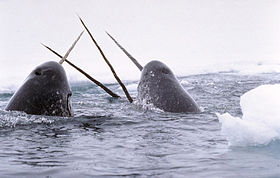 bundles that connected directly to their brains and auditory systems. Their tusks are actually sensory organs, like an eye or an ear, processing a wide array of external information. Narwhal tusks can detect temperature, sound, motion, barometric pressure, water salinity and the presence of both mates and fish. It also likely influences sound production and reception, like a long ivory antenna. Imagine if you had a single tooth that kept growing after you were born, just split through your lip and grew straight out into space, until it was half as long as you are tall, while helping you find dates, locate dinner, send messages to friends and get back home. Then you’d be as cool as a Narwhal.
bundles that connected directly to their brains and auditory systems. Their tusks are actually sensory organs, like an eye or an ear, processing a wide array of external information. Narwhal tusks can detect temperature, sound, motion, barometric pressure, water salinity and the presence of both mates and fish. It also likely influences sound production and reception, like a long ivory antenna. Imagine if you had a single tooth that kept growing after you were born, just split through your lip and grew straight out into space, until it was half as long as you are tall, while helping you find dates, locate dinner, send messages to friends and get back home. Then you’d be as cool as a Narwhal.
An Extraordinary World of Sound
But it’s the acoustic world of the Narwhal that impressed Dr. Christopher W. Clark. He’s a senior scientist at Cornell University Bioacous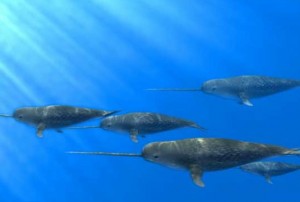 tic lab and he says a Narwhal’s hearing is extraordinary. “Their auditory cortex is ten times the size of a humans,” he says. “They can hear the world in a way we can’t even comprehend. They are completely dependent on sound and listening across large distances in order to survive.” Without their exceptional auditory abilities, they would not be able to mate, hunt or raise calves, which explains the often used expression, “A deaf whale, is a dead whale.” It’s also the reason Narwhals are in trouble, and why Ian Rowan in making his documentary. “Narwhals are on the brink of extinction,” Rowan says. “It keeps me up at night.”
tic lab and he says a Narwhal’s hearing is extraordinary. “Their auditory cortex is ten times the size of a humans,” he says. “They can hear the world in a way we can’t even comprehend. They are completely dependent on sound and listening across large distances in order to survive.” Without their exceptional auditory abilities, they would not be able to mate, hunt or raise calves, which explains the often used expression, “A deaf whale, is a dead whale.” It’s also the reason Narwhals are in trouble, and why Ian Rowan in making his documentary. “Narwhals are on the brink of extinction,” Rowan says. “It keeps me up at night.”
A Loud Threat
Large deposits of fossil fuel are often found beneath deep cold water, making Baffin Bay an ideal hunting ground for gas and oil survey crews. These cold dark-blue waters reach sudden and extraordinary depths, some over two-thousand feet deep and the average water temperature remains near zero year-round. This is the perfect place for Narwhals to feed and calve their young…it’s also the perfect place to drill for oil, geographically speaking.
But for centuries, Baffin Bay was protected from surveys and seismic mapping and industrial development, mostly 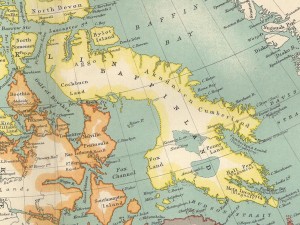 because of its unique ability to defend itself. The remote location, inhospitable environment, and un-navigable terrain made surveys difficult. The ice made drilling impossible. Enormous horizon-sized slabs of white ice locked up the bay and locked people out. Open water froze quickly, paving itself over with heavy capstones of slow solemn ice, making navigation treacherous. Moving water would freeze and vanish, whiteouts blinded travelers and drifting snow buried landmarks, shifting pack ice blocked exits and crushed boat hulls. Sudden storms tossed icebergs and boats violently at one another like toys in a tub. boats couldn’t navigate the water, Crews couldn’t survey sites, drills couldn’t get through the ice. This is how Baffin Bay kept itself protected for so long, by hiding itself under a thick blanket of quiet cold ice, which kept it safe for a very long time.
because of its unique ability to defend itself. The remote location, inhospitable environment, and un-navigable terrain made surveys difficult. The ice made drilling impossible. Enormous horizon-sized slabs of white ice locked up the bay and locked people out. Open water froze quickly, paving itself over with heavy capstones of slow solemn ice, making navigation treacherous. Moving water would freeze and vanish, whiteouts blinded travelers and drifting snow buried landmarks, shifting pack ice blocked exits and crushed boat hulls. Sudden storms tossed icebergs and boats violently at one another like toys in a tub. boats couldn’t navigate the water, Crews couldn’t survey sites, drills couldn’t get through the ice. This is how Baffin Bay kept itself protected for so long, by hiding itself under a thick blanket of quiet cold ice, which kept it safe for a very long time.
But now the ice is receding. As sea temperatures rise and ice packs recede, the Arctic Circle becomes an increasingly easier area to survey. Most people know that drilling for oil under the ocean involves environmental risks, but what many don’t realize is that just looking for oil can put underwater ecosystems at risk, especially seismic surveys.
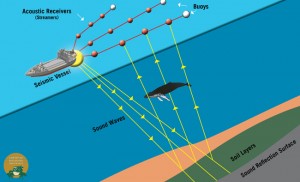 Seismic surveying is an outdated acoustic mapping technique used to locate deposits of gas and oil buried deep beneath the ocean floor. “There’s lots of other ways to find oil,” Rowan says. “This is just the cheapest.” A fleet of survey boats drive back and forth across a target area, each dragging large arrays seismic airguns behind them in the water. These air guns blast the water with high-frequency explosions every 15 seconds, at an ear-splintering 250 decibels, twice the level humans can withstand. “Air guns are designed to be loud,” Dr. Clark says, “because the sound has to travel long distances down through the water to reach the ocean floor.” They’ll have to be in Baffin Bay, Parts of which are over 2,000 feet deep. “Airguns are so loud that they disturb, injure or kill marine life, harm commercial fisheries, and disrupt coastal economies.”
Seismic surveying is an outdated acoustic mapping technique used to locate deposits of gas and oil buried deep beneath the ocean floor. “There’s lots of other ways to find oil,” Rowan says. “This is just the cheapest.” A fleet of survey boats drive back and forth across a target area, each dragging large arrays seismic airguns behind them in the water. These air guns blast the water with high-frequency explosions every 15 seconds, at an ear-splintering 250 decibels, twice the level humans can withstand. “Air guns are designed to be loud,” Dr. Clark says, “because the sound has to travel long distances down through the water to reach the ocean floor.” They’ll have to be in Baffin Bay, Parts of which are over 2,000 feet deep. “Airguns are so loud that they disturb, injure or kill marine life, harm commercial fisheries, and disrupt coastal economies.”
In 2015 The Canadian Government approved plans for a massive seismic survey in Baffin Bay and surrounding areas, despite urgent warnings from marine biologists and international wildlife conservation groups. Local Inuit tribes mounted a legal campaign last year, led by the Mayor of Clyde River, Jerry Natanine, who have seen fisrt-hand the impact of seismic blasting on Narwhals and other marine mammals. Reports of seals going deaf, Narwhals being scared out of critical feeding and calving grounds. 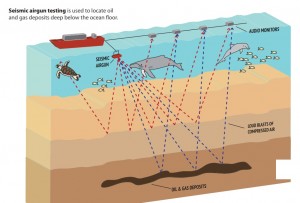
The blasts planned for Baffin Bay will need to reach the extraordinary depths of that region, requiring exceeding 250 decibels, more than twice what human ears can stand are repeated every 15 seconds, 24 hours a day, for five years. During Seismic mapping, Seismic airguns are towed behind ships and shoot loud blasts of compressed air through the water and miles into the seabed, which reflect back information about buried oil and gas deposits. These blasts harm marine mammals, sea turtles, fish and other wildlife.
Dr. Clark says these blasts are designed to be as loud as physically possibly, so they can travel long distances and reach the sea floor. “It’s so loud, it boils the water. It hits your head, your sinus cavity, your chest, its shocking. The sound travels incredible distances, I’ve recorded seismic blasts off the coast of Virginia, that were being set off in Ireland.” Other reported environmental impacts on marine life include temporary and permanent hearing loss, abandonment of habitat, disruption of mating and feeding, and even beach strandings and death. For whales and dolphins, which rely on their hearing to find food, communicate, and reproduce, being able to hear is a life or death matter. “A deaf whale is a dead whale.”
The Inuit Community at Clyde River relies heavily on the Narwhals migration to survive during the winter. There  limited access to food in this tiny remote arctic village, the people here literally hunt to eat. “We asked for an environmental impact assessment,” says Jerry Natanine, Mayor of Clyde River and Inuit Elder. “but they told us no.” They have attempted to stop the blasting legally, but has so far been unsuccessful. “If the Narwhals die, it will be the end of our community.”
limited access to food in this tiny remote arctic village, the people here literally hunt to eat. “We asked for an environmental impact assessment,” says Jerry Natanine, Mayor of Clyde River and Inuit Elder. “but they told us no.” They have attempted to stop the blasting legally, but has so far been unsuccessful. “If the Narwhals die, it will be the end of our community.”
Seismic mapping companies believe the safety measures they use negate damage. They employ techniques like “slow starts,” where decibel blasts are increased slowly, giving marine life a chance to leave the area. They also place watch boats around blasting perimeters to watch for whales and adhere to regulated mitigation zones around blasting areas to reduce harm. Environmentalists say none of this is near enough, but it does follow current seismic mapping laws, laws which many feel are outdated and inadequate.
One reason seismic mapping is being allowed in Baffin bay is a significant lack of scientific data about the harmful effects of seismic testing on Narwhals. The research has simply not been done. “This research is very hard to do,” Dr. Nweeia says. “These animals live in the most remote areas and you can’t easily do field testing. And even if you could do it, you won’t be able to get a permit to conduct such tests. We shouldn’t need to prove it. Should we? We all know its hurting them,The scientists know and the inuit do too, especially the ones who’ve lived with seismic blasting in the past. They say the whales and the seals go deaf. Narwhals flee the area, run far from migration routes and wind up trapped under ice in unfamiliar areas. we know it hurting them, it’s just that don’t have the scientific proof.”
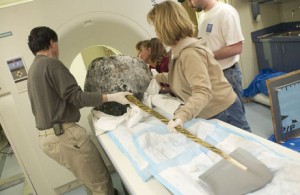 That’s because in order to prove seismic blasting harms and/or kills Narwhals (or any marine mammal) scientists would basically have to remove a Narwhal from the ocean, put it in a controlled tank environment and then deafen, damage and kill it with sound, in order to prove that’s what happens during seismic blasting. Nobody’s going to do that and nobody’s going to get permission to do that. This means there’s no scientific data to prove seismic surveying harms marine life, so lawmakers don’t have the data they need to make new laws, and scientists don’t have the means to get it.
That’s because in order to prove seismic blasting harms and/or kills Narwhals (or any marine mammal) scientists would basically have to remove a Narwhal from the ocean, put it in a controlled tank environment and then deafen, damage and kill it with sound, in order to prove that’s what happens during seismic blasting. Nobody’s going to do that and nobody’s going to get permission to do that. This means there’s no scientific data to prove seismic surveying harms marine life, so lawmakers don’t have the data they need to make new laws, and scientists don’t have the means to get it.
Crowdsourcing scientific studies?
One idea to obtain required data is to re-create a Narwhal ear and its marine environment ‘virtually’ and then use physics to scientifically test it. “I could do that, I absolutely could create a virtual Narwhal ear,” says Dr. Darlene Ketten, a marine biologist and neuroanatomist specializing in underwater hearing and mechanisms of hearing loss. She’s documented damag ed auditory systems of marine mammals, including beached whales with ruptured eardrums. But in order to virtually recreate a Narwhals ear, she needs the funding.” It would cost me about twenty-thousand dollars to create a virtual Narwhal ear, and the problem is there’s not much money for marine mammal studies. The big funders focus on human research and the environmental groups help fund individual situations. Crowdsourcing and kickstarter funds for stopping this blasting or saving that particular place, when what we really need is to start funding is scientific studies that produce critical data that could protect entire species, instead of singular events.”
ed auditory systems of marine mammals, including beached whales with ruptured eardrums. But in order to virtually recreate a Narwhals ear, she needs the funding.” It would cost me about twenty-thousand dollars to create a virtual Narwhal ear, and the problem is there’s not much money for marine mammal studies. The big funders focus on human research and the environmental groups help fund individual situations. Crowdsourcing and kickstarter funds for stopping this blasting or saving that particular place, when what we really need is to start funding is scientific studies that produce critical data that could protect entire species, instead of singular events.”
Seismic Blasting
As of now, blasting in Baffin Bay has been postponed until the summer of 2017.
 That’s when The Norway-based energy consortium of oil and gas exploration companies, comprised of Petroleum Geo Services, (PGS) TGS-NOPEC Geophysical Company ASA and Multi Klient Invest AS will attempt to us a license granted by the National Energy Board to use seismic testing up and down the Davis Strait.
That’s when The Norway-based energy consortium of oil and gas exploration companies, comprised of Petroleum Geo Services, (PGS) TGS-NOPEC Geophysical Company ASA and Multi Klient Invest AS will attempt to us a license granted by the National Energy Board to use seismic testing up and down the Davis Strait.
Currently, there are no environmental laws to stop them and the Inuit community of Clyde River’s initial case was dismissed by Federal Court of Appeal judges last year. One remaining light shines – the community has since sought leave to appeal at the Supreme Court of Canada and the Clyde River Inuit community is still waiting to see if the Supreme Court of Canada will hear this case. Until then, people are gathering to show support.
“I’m touched by how many people have joined our cause” Jerry Natanine smiles. “People care about us. They care about the animals. We thought we were tiny and insignificant, but this has turned into a big movement, a movement of love.”
Fund a Virtual Narwhal Ear:
Interested in helping to fund a virtual Narwhal ear? Send us an email and we’ll get your information to Dr. Darlene Ketten directly. heather@abeautiful.world
Biographies
Dr. Martin Nweeia is a clinical instructor at the Harvard School of Dental Medicine, research associate in the Marine Mammal Program at the Smithsonian Institution and in the Department of Mammals at the Harvard Museum of Comparative Zoology. He is principal investigator of Narwhal Discoveries, and the Narwhal Genome Project. He holds doctorates in dental medicine and dental surgery from the Case School of Dental Medicine. Martin has researched narwhal tusk function for 15 years, on over 15 High Arctic expeditions, carrying the famed Explorers “Flag” on 12 of them. His work has been featured in 5 films from The National Geographic Society, 2 from the BBC, and one from the French show “Decouverte”. In 2007, Nweeia was an invited speaker at the Philip Hague Abelson Lecture Series of the American Association for the Advancement for Science. NPR’s Pulse of the Planet Series featured a 10-part show with Dr. Nweeia. His pioneering work on the narwhal was described by the National Science Foundation in a “Highlight” to the US Congress as “a model for future scientists to utilize as they seek to better understand our world.
Christopher W. Clark, MSEE, PhD, is an Imogene P. Johnson Senior Scientist, and Director of the Bioacoustics Research Program at the Cornell Lab of Ornithology and Dept. of Neurobiology at Cornell University. Cornell’s Bioacoustics Research Program develops digital technology, equipment and software to record and analyze the sounds of wildlife around the globe. By listening to wildlife, they aim to advance the understanding of animal communication and monitor the health of wildlife populations, providing policy makers, industries, and governments with information that helps minimize the impact of human activities on wildlife and natural environments. Christopher’s passions include all sounds in the natural world, conveying the beauty of sound visually, conserving wildlife, the poetry of music and music of poetry.
Darlene Ketten is a marine biologist and neuroanatomist specializing in underwater hearing and mechanisms of hearing loss. She received a B.A./B.S. from Washington University (Biology and French), M.S. from Massachusetts Institute Technology. (Earth and Planetary Sciences/Biological Oceanography), and Ph.D. from Johns Hopkins Medical Institutions (jointly awarded in Neuroanatomy, Behavioral Ecology, and Experimental Radiology). She currently holds joint appointments as a Professor of Imaging and Applied Physics at Curtin University, Scientist emeritus at Woods Hole Oceanographic Institution, and Assistant Clinical Professor at Harvard Medical School. She is the Chief Scientist and Director of the WHOI Computerized Scanning and Imaging Facility
Deeper Research Articles
- Seismic Mapping in the United States: http://oceana.org/our-work/climate-energy/seismic-airgun-blasting/overview
- Marine Mammals Underwater Hearing: Sound Production, Sound Reception, and Sound Impacts:
Archive Page for Marine Animal Sound Production and Reception - Discovery of Sound in the Sea: http://www.dosits.org/
- Effects of Airgun Sounds on Bowhead Whale Calling Rates: Evidence for Two Behavioral Thresholds: http://journals.plos.org/plosone/article?id=10.1371/journal.pone.0125720
- Airgun Pulses in Shallow Water with Implications for Effects on Small Marine Mammals http://journals.plos.org/plosone/article?id=10.1371/journal.pone.0133436
- High-Resolution Analysis of Seismic Air Gun Impulses and Their Reverberant Field as Contributors to an Acoustic Environment: https://mail.google.com/mail/u/0/#inbox/15310a131c4771bf?projector=1
- Scientific Study: Wisniewska, D.M., Kyhn, L.A., Tougaard, J., Simon, M., Lin, Y.-T., Newhall, A., Beedholm, K., Lynch, J. & Madsen, P.T. 2014. Propagation of airgun pulses in Baffin Bay 2012. Aarhus University, DCE – Danish Centre for Environment and Energy, 150 pp. Scientific Report from DCE – Danish Centre for Environment and Energy No. 109 http://dce2.au.dk/pub/SR109.pdf


